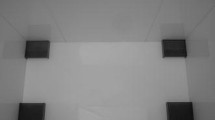Summary
Golden hamsters hoard food by carrying it back to their nest-site along a fairly direct path. 7 out of 12 animals continued to orientate in this way after passive transportation to the food source and the simultaneous elimination of visual, olfactory and acoustical cues. Experiments in which the hamsters tried to reach their nest-box from an unfamiliar place suggest that they orientate in a given direction with respect to a ‘compass’, the nature of which has still to be determined.
Similar content being viewed by others
References
J. Bovet, in: Animal Migration, Navigation, and Homing, p 405. Ed. K. Schmidt-Koenig and W. T. Keeton. Springer Verlag, Berlin Heidelberg New York 1978.
J. K. Joslin, Adv. Ecol. Res.10, 63 (1977).
S. A. Barnett, Rhondda G. Dickson, T. G. Marples and E. Radha, Behav. Proc.3, 29 (1978).
J. Vauclair, H. Gramoni J-J. Meyer and M. Zinder, Biol. Behav.2, 353 (1977).
E. Batschelet: Statistical methods for the analysis of problems in animal orientation and certain biological rhythms. The American Institute of Biological Sciences, Washington, DC, 1965.
S. Siegel: Nonparametric Statistics for the Behavioral Sciences. International Student Edition. McGraw-Hill, New York Toronto London 1956.
J. S. Barlow, J. theor. Biol.6, 76 (1964).
W. Wiltschko and R. Wiltschko, Science176, 62 (1972).
M. L. Kreithen, in: Animal Migration, Navigation, and Homing, p 25. Ed. K. Schmidt-Koenig and W. T. Keeton, Springer Verlag, Berlin Heidelberg New York 1978.
K. Bättig and J. Schlatter, Animal Learning Behav.7, 99 (1979).
D. S. Olton, Am. Psychol.34, 583 (1979).
H. Mittelstaedt and M-L. Mittelstaedt, Fortschr. Zool.21, 46 (1973).
E. Teroni and A. S. Etienne, in preparation.
Author information
Authors and Affiliations
Additional information
Acknowledgments. This research is supported by the Fonds national suisse de la recherche scientifique, grant No. 3.349.74. I am most grateful to Dr E. Batschelet† and Dr P. Mengal for their advice in the statistical treatment of the data, to Dr J. Bovet for a critical reading of the manuscript, to Drs H. Mittelstaedt, E. Kramer and H. Wallraff for discussions, to J. Stryjenski, M. Lançon, O. Wehrli and R. Schumacher for technical advice and help, to Mrs E. Teroni and Dr J. Vauclair for their collaboration and to many students for their help in carrying out the experiments.
Rights and permissions
About this article
Cite this article
Etienne, A.S. The orientation of the golden hamster to its nest-site after the elimination of various sensory cues. Experientia 36, 1048–1050 (1980). https://doi.org/10.1007/BF01965961
Published:
Issue Date:
DOI: https://doi.org/10.1007/BF01965961




